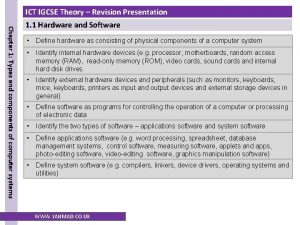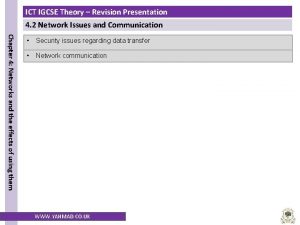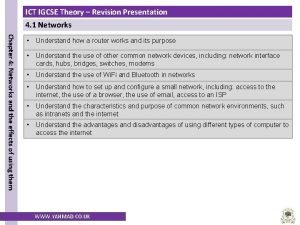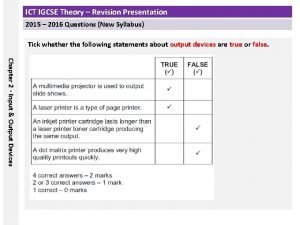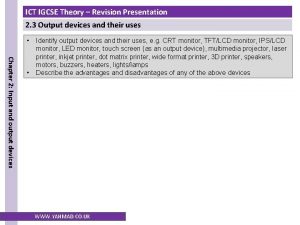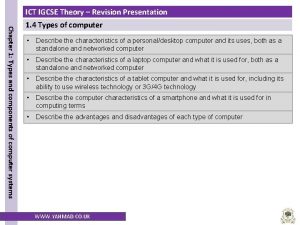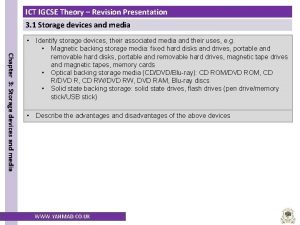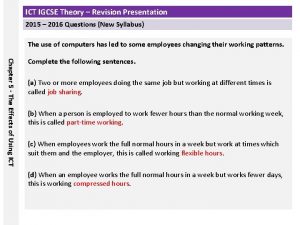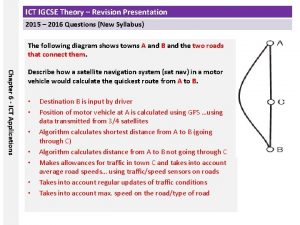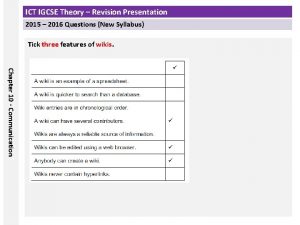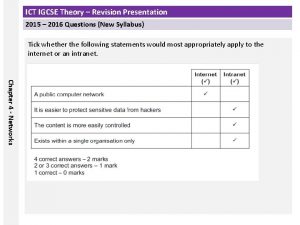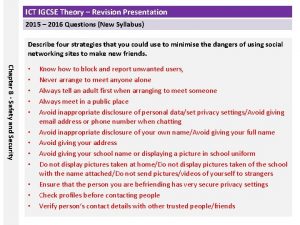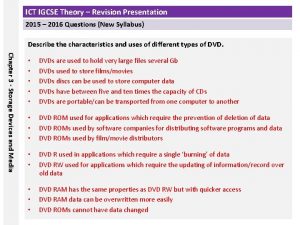ICT IGCSE Theory Revision Presentation 2015 2016 Questions







- Slides: 7

ICT IGCSE Theory – Revision Presentation 2015 – 2016 Questions (New Syllabus) Tick whether the following statements about output devices are true or false. Chapter 2 - Input & Output Devices

ICT IGCSE Theory – Revision Presentation 2015 – 2016 Questions (New Syllabus) Tick the most appropriate method of inputting data for the following uses. Chapter 2 - Input & Output Devices

ICT IGCSE Theory – Revision Presentation 2015 – 2016 Questions (New Syllabus) Chapter 2 - Input & Output Devices • The inbuilt device which moves the cursor when using a laptop is called a touch pad. • The device used for selecting an icon so a bar code label can be printed in a supermarket is called a touch screen. • The device used for controlling a pointer on a screen when the user has limited motor skills is called a trackerball. • • • This is provided with a laptop to imitate the functions of a mouse. Touchpad This is not a mouse but is used to manoeuvre objects around the screen in computer video games. Joystick This is used to type in text. Keyboard This is used for direct input of hard copy images. Scanner • • •

ICT IGCSE Theory – Revision Presentation 2015 – 2016 Questions (New Syllabus) Chapter 2 - Input & Output Devices Data can be input to a computer using direct data entry methods. Write down the most appropriate device to input the following: (a) information from the chip in an electronic passport RFID reader (b) text from an id card Optical Character Reader (c) account details from the front of a credit card at an EFTPOS terminal Chip reader (d) account details from the back of a credit card at an EFTPOS terminal Magnetic stripe reader

ICT IGCSE Theory – Revision Presentation 2015 – 2016 Questions (New Syllabus) Chapter 2 - Input & Output Devices Data can be input to a computer using different devices. Write down the most appropriate input device which will enable you to: (a) type an essay Keyboard (b) select options from a drop down menu whilst moving the device Mouse (c) read the temperature Temperature sensor (d) fly an aircraft in a video game. Joystick

ICT IGCSE Theory – Revision Presentation 2015 – 2016 Questions (New Syllabus) Describe how MICR is used to read these details from the cheque. Chapter 2 - Input & Output Devices • • Requires a special Magnetic Ink Character reader/scanner/Details are scanned The magnetic ink on the cheque passes over a magnet in the reader/scanner which charges/magnetises the ink The MICR reader/scanner then reads the magnetic signal given out by the magnetic ink characters on the cheque. Each character produces a unique signal which is read and translated by the MIC reader

ICT IGCSE Theory – Revision Presentation 2015 – 2016 Questions (New Syllabus) Discuss why different user interfaces require the use of different types of input devices. Chapter 2 - Input & Output Devices • • • With a GUI you just click on an icon With a GUI icons represent applications Separate windows are used for different pieces of work/software With a GUI menus are offered to help choose an action Moving a mouse enables users to manoeuvre a pointer around a screen A mouse can be used to drag windows/icons around a screen People with physical disabilities can use a trackerball to manoeuvre the pointer around a screen Pointing devices are easier to control a pointer/menu selection/icon clicking Joysticks can be used to mimic the behaviour of a mouse Buttons on the mouse enable users to select icons Buttons on a mouse enable users to see menus on a screen Touchscreen can be used to directly select options from a screen
